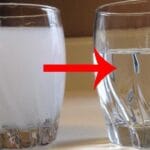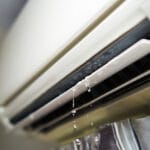Are you facing issues with your Bosch washing machine’s weight sensor? This common problem can disrupt your laundry routine and cause frustration.
Bosch washing machines are known for their reliability and advanced features. However, like any appliance, they can encounter technical issues. One such issue is with the weight sensor, which helps the machine determine the load size and adjust the washing cycle accordingly.
When this sensor malfunctions, it can lead to incorrect wash cycles, water usage, and detergent amounts. Understanding this problem can help you troubleshoot and find solutions. In this blog post, we will delve into the Bosch washing machine weight sensor problem, its symptoms, and possible fixes to get your machine back in optimal working condition.
Common Symptoms
Experiencing issues with your Bosch washing machine? The weight sensor might be the culprit. Identifying common symptoms can help you troubleshoot and solve the problem quickly. Here, we explore some typical signs that your Bosch washing machine’s weight sensor is malfunctioning.
Unbalanced Load
An unbalanced load is a frequent symptom of weight sensor issues. Your washing machine might make unusual noises during the spin cycle. The drum may thump or bang against the sides. Clothes might not be evenly distributed inside the drum. This can cause the washing machine to stop mid-cycle.
Error Codes
Error codes are another telltale sign of a weight sensor problem. Bosch washing machines display specific codes when something goes wrong. Look for codes like E02 or E03. These codes often indicate a problem with the weight sensor. Refer to the user manual for more details on error codes.

Credit: www.youtube.com
Initial Checks
Facing issues with your Bosch washing machine? The weight sensor problem is a common issue. Before calling a technician, perform these initial checks. It could save you time and money.
Power Supply
Ensure the washing machine is plugged in properly. Check if the power outlet is working. You can test it with another device. Look at the power cord for any signs of damage. A faulty power supply can disrupt the weight sensor.
Water Supply
Examine the water inlet hoses. They should be connected firmly. Check for any blockages in the hoses. Ensure that the water supply is turned on. A poor water supply can affect the washing machine’s performance. Inspect the filters for any debris. Clean them if necessary. This ensures a smooth water flow.
Inspecting The Weight Sensor
Having trouble with your Bosch washing machine? The weight sensor could be the culprit. Inspecting the weight sensor is crucial to ensure your machine works efficiently. This sensor helps in balancing the load and optimizing the wash cycle. Let’s walk through the inspection process step by step.
Location
First, locate the weight sensor. Generally, the weight sensor is found near the drum. It may be attached to the base or the side. The sensor is a small, rectangular device with wires connected to it. Look for it around these areas.
| Location | Description |
|---|---|
| Base | Attached to the bottom of the drum |
| Side | Mounted on the side of the drum |
Physical Damage
Inspect the weight sensor for any physical damage. Cracks, burns, or broken wires are common issues. Any visible damage can affect the sensor’s performance. Use a flashlight to get a better view. Ensure the wires are properly connected and not frayed.
If you notice any damage, replacing the sensor might be necessary. A damaged sensor can lead to imbalanced loads and poor washing results. Regular inspection helps in early detection, preventing bigger issues.
By following these steps, you can ensure your Bosch washing machine runs smoothly. Remember, a healthy weight sensor leads to better washing performance.
Testing The Sensor
If you suspect a weight sensor issue in your Bosch washing machine, you need to test the sensor. A malfunctioning sensor can cause inaccurate weight readings, which can lead to improper wash cycles. Here, we will guide you on how to use a multimeter and check resistance values to ensure the sensor is working correctly.
Multimeter Use
To test the weight sensor, you will need a multimeter. Follow these steps:
- Turn off the washing machine and unplug it.
- Remove the weight sensor from the machine.
- Set your multimeter to the ohms (Ω) setting.
- Connect the multimeter probes to the sensor terminals.
- Read the display on your multimeter.
A stable reading indicates the sensor is functioning. If the reading fluctuates or shows zero, the sensor might be faulty.
Resistance Values
Checking the resistance values is crucial. The weight sensor should have specific resistance values. Here is a table of common values:
| Weight (kg) | Resistance (Ω) |
|---|---|
| 0 | 10 Ω |
| 5 | 20 Ω |
| 10 | 30 Ω |
Compare your sensor’s readings with the table. If the values match, the sensor is good. If not, consider replacing it. Consistent resistance values are important for accurate weight detection.
Cleaning The Sensor
Cleaning the sensor in your Bosch washing machine can solve many performance issues. A clean sensor ensures accurate weight measurement, leading to better washing cycles. This section will guide you through the process of cleaning the weight sensor.
Removing Debris
First, unplug your washing machine for safety. Locate the sensor, usually found near the drum. Carefully remove any visible debris using a soft cloth or brush.
Consider using a vacuum cleaner to remove stubborn dirt. Be gentle to avoid damaging the sensor. Check the sensor connections for dust and clean them as well.
Proper Maintenance
Regular maintenance of the weight sensor can prevent future issues. Clean the sensor every few months to keep it in good condition.
Avoid using harsh chemicals; a damp cloth is usually enough. Inspect the sensor and its connections regularly for any signs of wear or damage.
Follow the manufacturer’s guidelines for the best results. Proper care extends the life of your washing machine and improves its efficiency.
:max_bytes(150000):strip_icc()/repair-washing-machine-water-level-fill-switch-1824607-hero-f7677789212746bdb1be2eaad58be1dc.jpg)
Credit: www.thespruce.com
Replacing The Sensor
Replacing the sensor in your Bosch washing machine is crucial for accurate weight detection. A faulty sensor can lead to uneven loads and poor washing performance. This guide will help you replace the sensor efficiently.
Part Identification
First, you need to identify the correct sensor. Check the model number of your Bosch washing machine. Refer to the user manual or the manufacturer’s website for the sensor part number. Ensure you purchase the correct one for compatibility.
Installation Steps
- Unplug the washing machine from the power source.
- Remove the back panel using a screwdriver. This will expose the internal components.
- Locate the faulty sensor. It is usually found near the drum or the base of the machine.
- Disconnect the wires attached to the old sensor. Note the positions for reassembly.
- Remove the old sensor by unscrewing or unfastening it. Set it aside.
- Install the new sensor by securing it in place with screws or fasteners.
- Reconnect the wires to the new sensor, ensuring they match the original configuration.
- Replace the back panel and secure it with screws.
- Plug the washing machine back into the power source.
- Test the washing machine to ensure the sensor is functioning correctly.
Following these steps will help you replace the sensor in your Bosch washing machine effectively. Regular maintenance is essential for optimal performance.
Calibrating The Sensor
Calibrating the sensor in your Bosch washing machine can resolve many issues. A common problem is the weight sensor malfunctioning. This can cause your machine to misjudge the load size. Fixing this often involves calibrating the sensor. Below, you’ll find detailed steps to help you do this.
Reset Procedure
First, you need to reset the sensor. Follow these steps to reset it:
- Unplug the washing machine from the power source.
- Wait for about 10 minutes to ensure all residual power drains.
- Plug the machine back in and turn it on.
- Run an empty cycle to see if the sensor resets.
If the issue persists, move to the next step: balancing the load.
Balancing Loads
Uneven loads can confuse the weight sensor. To balance the loads, follow these tips:
- Distribute clothes evenly in the drum.
- Avoid washing heavy items with light ones.
- Check that the machine is on a flat surface.
Use the table below for quick tips on load balancing:
| Load Type | Action |
|---|---|
| Heavy Items | Wash separately or with similar weight items. |
| Light Items | Combine with other light items. |
| Mixed Items | Balance by distributing evenly. |
Once you balance the load, the sensor should work correctly. This simple step can often solve the problem.

Credit: www.reddit.com
When To Call A Professional
A Bosch washing machine with a weight sensor problem can be frustrating. You might wonder whether to fix it yourself or call a professional. Sometimes, professional help is the best option to avoid further damage and ensure proper repair.
Complex Issues
Sometimes, the weight sensor problem is not just a simple fix. Advanced issues can arise that require a professional’s expertise. For example, if the sensor wiring is damaged, it can lead to incorrect weight readings. This could result in improper washing cycles and potential machine damage.
A professional technician can diagnose these complex issues accurately. They have the right tools and experience to fix the problem. Trying to fix it yourself might worsen the situation. It could even void your warranty.
Warranty Considerations
Your Bosch washing machine likely comes with a warranty. This warranty can save you money on repairs. But, any attempt to fix the machine yourself can void this warranty. This means you would have to pay for all future repairs out of pocket.
Before attempting any repairs, check your warranty terms. It might be best to call a professional to handle the repair. This way, you can ensure your warranty remains valid.
Below is a table summarizing when to call a professional versus attempting a DIY fix:
| Situation | DIY Fix | Call a Professional |
|---|---|---|
| Simple Sensor Reset | ✔ | ✘ |
| Damaged Wiring | ✘ | ✔ |
| Warranty Repair | ✘ | ✔ |
| Complex Diagnostics | ✘ | ✔ |
Frequently Asked Questions
What Is A Weight Sensor In A Bosch Washing Machine?
A weight sensor measures the load of laundry in the washing machine. It adjusts water and detergent levels accordingly.
Why Is My Bosch Washing Machine Showing A Weight Sensor Error?
A weight sensor error can occur due to overloading, sensor malfunction, or wiring issues. Check these first.
How Do I Reset The Weight Sensor On My Bosch Washing Machine?
To reset, unplug the machine for a few minutes. Then, plug it back in and restart.
Can I Fix The Weight Sensor Problem Myself?
You can try basic troubleshooting like checking the load. For technical issues, it’s best to call a professional.
How Much Does It Cost To Replace A Bosch Washing Machine Weight Sensor?
Replacement costs vary. Typically, it ranges from $100 to $200 including parts and labor.
Conclusion
Experiencing issues with your Bosch washing machine weight sensor can be frustrating. Addressing these problems promptly ensures smooth laundry days. Regular maintenance helps prevent such issues. Consult the user manual for troubleshooting tips. Sometimes, seeking professional help is necessary. Keeping your machine in good condition extends its lifespan.
A well-functioning washing machine saves time and effort. Remember, a little care goes a long way. Stay on top of maintenance to enjoy hassle-free laundry.




